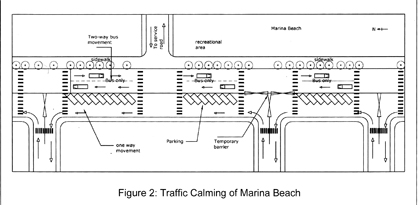|
(Continued from last fortnight)
With the phenomenal growth in the number of motor vehicles in the cities, road traffic conditions in recreational areas are deteriorating day by day. Due to inadequacies in the transport system, road infrastructure, parking facilities and pedestrian safety measures, there is acute traffic congestion, delay, increasing number of accidents and, above all, considerable environmental degradation. Traffic calming techniques will help to reduce the negative effects of motor vehicle use, enhance the quality of life, and provide a safer environment for pedestrians, children and the aged in recreational areas.
Figure 1 shows the conceptual plan for a recreational area with an abutting road having perpendicular access roads. This plan will ensure diversion of through traffic and full depth of penetration for destined traffic, reduce speed, increase parking spaces, ensure pedestrian safety, and improve the environment of the area. Such a scheme can be introduced in the Elliot’s Beach area in Chennai with minor modifications in the road system.
Marina Beach
 |
In places like Marina Beach, a traffic calming scheme as shown in Figure 2 can be implemented from 4.00 p.m. to 10.00 p.m. on Sundays and public holidays. For the convenience of the public, buses should be allowed to use the eastern part of the carriageway for both directions of movement, and operate within a speed limit of 25 kmph. Special shuttle bus services to a few selected destinations can be introduced to operate during these hours. The western part of the carriageway should be used by other vehicles in a one-way direction as shown in the figure. Temporary barriers or median islands have to be provided in the middle of the carriageway to separate buses from other vehicles, but these vehicles will be provided access to the service road for the purpose of parking. Temporary islands have to be formed at appropriate places for channelisation of traffic. Traffic movement on the service road should also be suitably modified, so that traffic will move in segments, but not right through. All these measures will help to change the environment of the area and also benefit the common man.
Traffic calming measures should also be introduced in a phased manner in areas of places of worship, hospital areas and other such areas in the cities.
Conclusions
Traffic calming methods will help to change the behaviour of motorists in accordance with the characteristics of the recreational area in which they move. These measures will reduce vehicle speed, divert through traffic, improve road safety and also enhance the quality of life. Traffic calming is only a means to an end, the end product being good living in a better environment.
Editor’s Note: Last fortnight we had promised that today we would look at a residential zone. That’s what the printer’s devil made of what should have been a ‘recreational area’.
(Next fortnight: A Shopping Area)
|